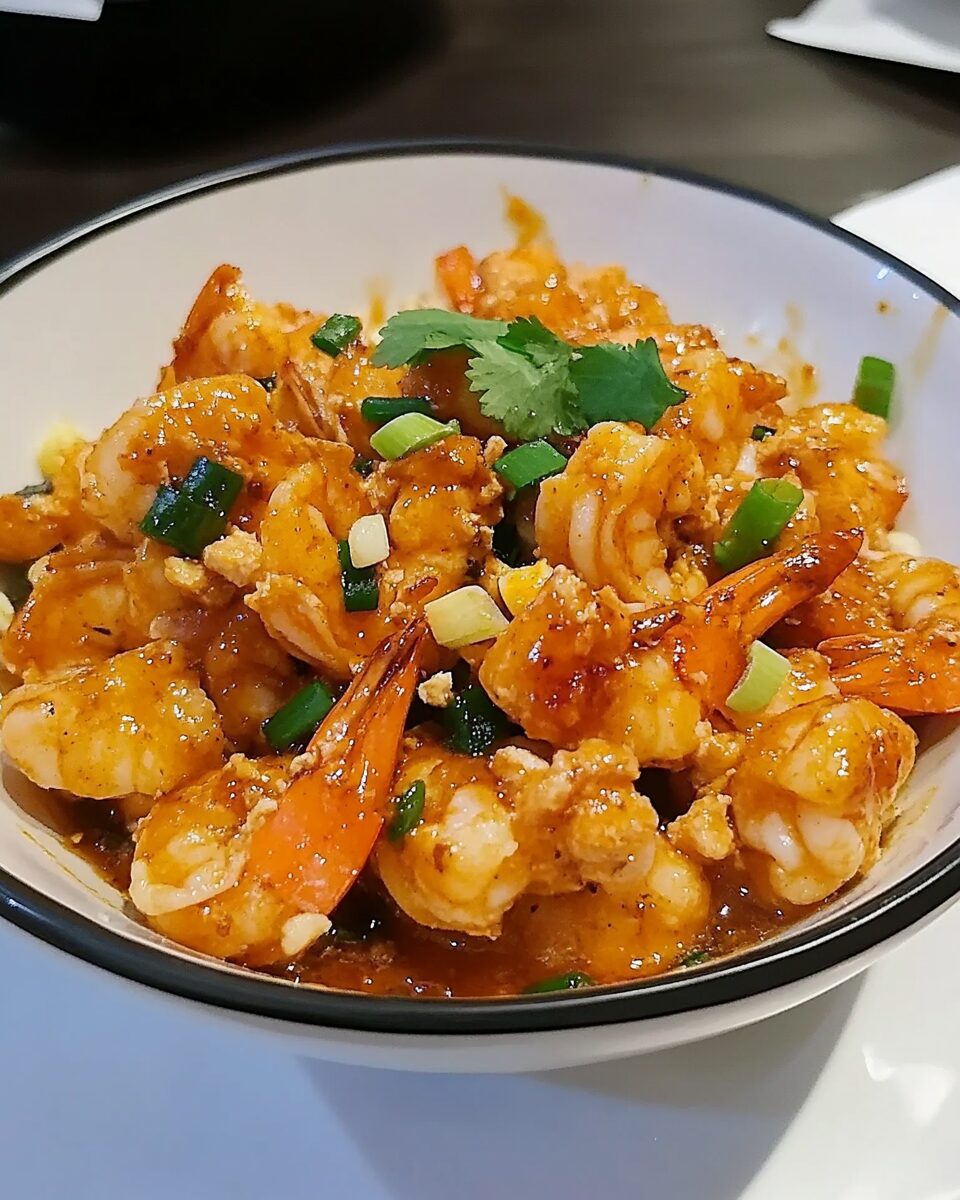Szechwan Shrimp is a spicy and flavorful Chinese dish that combines tender shrimp with a tangy sauce, making it a delightful option for dinner.
Full Recipe:
Ingredients:
- 4 tablespoons water
- 2 tablespoons ketchup
- 1 tablespoon soy sauce
- 2 teaspoons cornstarch
- 1 teaspoon honey
- ½ teaspoon crushed red pepper
- ¼ teaspoon ground ginger
- 1 tablespoon vegetable oil
- ¼ cup sliced green onions
- 4 cloves garlic, minced
- 12 ounces cooked shrimp, tails removed
Directions:
- In a small bowl, mix together water, ketchup, soy sauce, cornstarch, honey, crushed red pepper, and ground ginger until well combined; set aside.
- Heat vegetable oil in a large skillet over medium-high heat. Add green onions and garlic; cook and stir until fragrant, about 30 seconds.
- Add cooked shrimp to the skillet; toss to coat with oil.
- Pour in the reserved sauce mixture. Cook and stir until the sauce is bubbly and has thickened.
Nutritional Facts (per serving):
- Calories: 252
- Total Fat: 9g
- Saturated Fat: 1.5g
- Cholesterol: 110mg
- Sodium: 330mg
- Total Carbohydrates: 14g
- Dietary Fiber: 3g
- Sugars: 6g
- Protein: 15g
The Origin of Szechwan Shrimp
Szechwan Shrimp takes inspiration from Sichuan cuisine, which is famous for its bold and spicy flavors. Sichuan province, located in southwestern China, is known for its love of heat and the distinct numbing sensation provided by Sichuan peppercorns. Unlike regular black pepper or chili peppers, Sichuan peppercorns contain a compound called hydroxy-alpha sanshool, which creates a tingling, numbing effect on the tongue.
While the traditional Sichuan cooking method often involves deep frying proteins before stir-frying them with a spicy sauce, this version of Szechwan Shrimp is lighter and more accessible. The dish maintains the essence of Sichuan cuisine while offering a balance of heat and sweetness that appeals to a wide audience.
Although Szechwan Shrimp isn’t a direct replication of an ancient Chinese recipe, it is a popular Westernized adaptation that brings the flavors of Sichuan cuisine to home kitchens worldwide. This dish is commonly found on Chinese restaurant menus across North America and has gained popularity due to its bold flavors and simple preparation.
Why You’ll Love Szechwan Shrimp
- Quick and Easy: This dish takes less than 30 minutes to prepare, making it ideal for busy weeknights.
- Bold and Flavorful: The combination of garlic, ginger, soy sauce, and red pepper creates a deeply satisfying taste.
- Healthy and Nutritious: Shrimp is a lean protein that’s low in calories but high in nutrients, making this dish a great option for health-conscious eaters.
- Customizable: You can easily adjust the spice level by increasing or decreasing the amount of red pepper or adding Sichuan peppercorns for an authentic kick.
- Pairs Well with Many Sides: Serve it with steamed rice, fried rice, stir-fried vegetables, or noodles for a complete meal.
The Role of Shrimp in Asian Cuisine
Shrimp is a staple in many Asian cuisines, and it holds a special place in Chinese cooking. It symbolizes happiness and good fortune, often being served during festive occasions such as Chinese New Year. In Sichuan cuisine, shrimp is frequently used in stir-fry dishes because it quickly absorbs flavors while maintaining its firm texture.
Shrimp is also incredibly nutritious, providing essential vitamins and minerals like iodine, selenium, and vitamin B12. It’s a great protein source for those looking to maintain a healthy diet without consuming too much fat. The light yet meaty texture of shrimp makes it an excellent canvas for bold seasonings, allowing it to shine in dishes like Szechwan Shrimp.
Key Flavor Components of Szechwan Shrimp
- Spice: Crushed red pepper or chili paste brings heat to the dish, while Sichuan peppercorns (if used) add a numbing sensation.
- Savory Umami: Soy sauce enhances the depth of flavor, giving the dish its signature salty and rich taste.
- Sweetness: A touch of honey or sugar balances the heat and adds complexity.
- Aromatics: Garlic and ginger provide a fragrant base that intensifies the overall flavor profile.
These flavors combine harmoniously to create a dish that is not just spicy but also layered with depth, making every bite an experience.
How to Customize Szechwan Shrimp
One of the best things about Szechwan Shrimp is its versatility. You can modify the recipe to suit your taste preferences and dietary needs. Here are some customization ideas:
- Adjusting Spice Levels: If you love intense heat, add more crushed red pepper or include Sichuan peppercorns for an authentic numbing effect. For a milder version, reduce the spice and add a little more honey or sugar.
- Adding Vegetables: Bell peppers, snap peas, carrots, and mushrooms all pair well with this dish. Adding veggies not only enhances the flavor but also increases the nutritional value.
- Changing Proteins: While shrimp is the classic choice, you can use chicken, beef, or tofu as a substitute. Each protein absorbs the sauce beautifully.
- Making it Gluten-Free: Use tamari or coconut aminos instead of soy sauce to make this dish gluten-free without sacrificing flavor.
Best Side Dishes to Serve with Szechwan Shrimp
To make a complete meal, consider pairing Szechwan Shrimp with these delicious side dishes:
- Steamed White or Brown Rice: The mildness of rice helps balance the bold flavors of the shrimp.
- Fried Rice: For a heartier option, try serving it with egg fried rice or vegetable fried rice.
- Stir-Fried Vegetables: A mix of broccoli, bell peppers, and snow peas complements the dish beautifully.
- Lo Mein or Ramen Noodles: Toss cooked noodles with a bit of sesame oil and soy sauce for an easy side.
- Cucumber Salad: A chilled cucumber salad with vinegar dressing offers a refreshing contrast to the spicy shrimp.
Tips for Making the Best Szechwan Shrimp
- Use Fresh Shrimp: Fresh or high-quality frozen shrimp work best. If using frozen shrimp, thaw them properly before cooking.
- Don’t Overcook the Shrimp: Shrimp cook quickly and can become rubbery if overdone. They should turn pink and opaque in just a couple of minutes.
- Balance the Flavors: Adjust the spice, sweetness, and saltiness to your preference. Taste the sauce before adding it to the shrimp to ensure the right balance.
- Cook Over High Heat: A hot pan ensures that the shrimp sear properly and absorb the flavors quickly.
Conclusion
Szechwan Shrimp is a fantastic dish that brings the fiery, bold flavors of Sichuan cuisine to your kitchen in an easy and accessible way. With its combination of heat, umami, and slight sweetness, it’s a dish that appeals to a wide range of palates.






